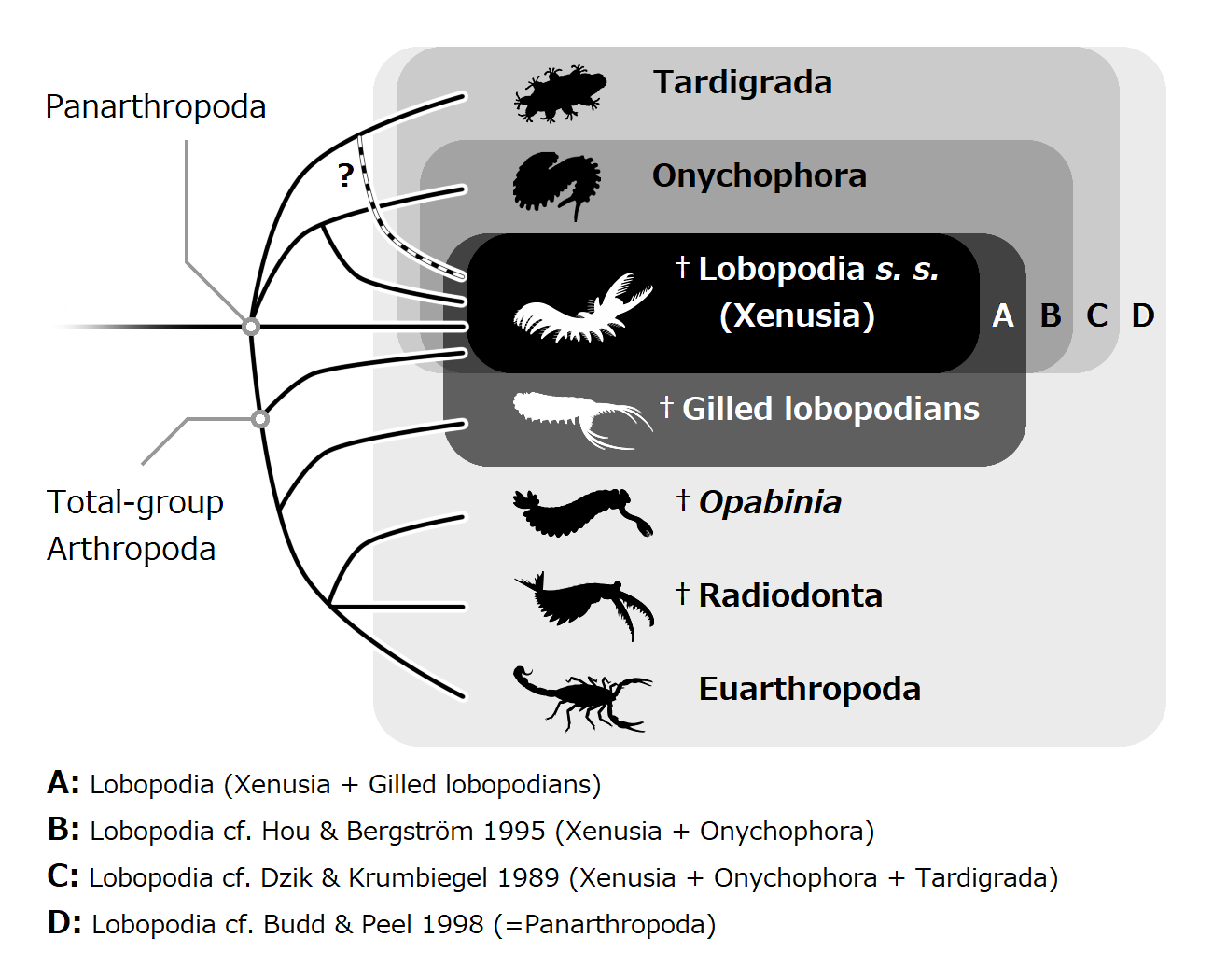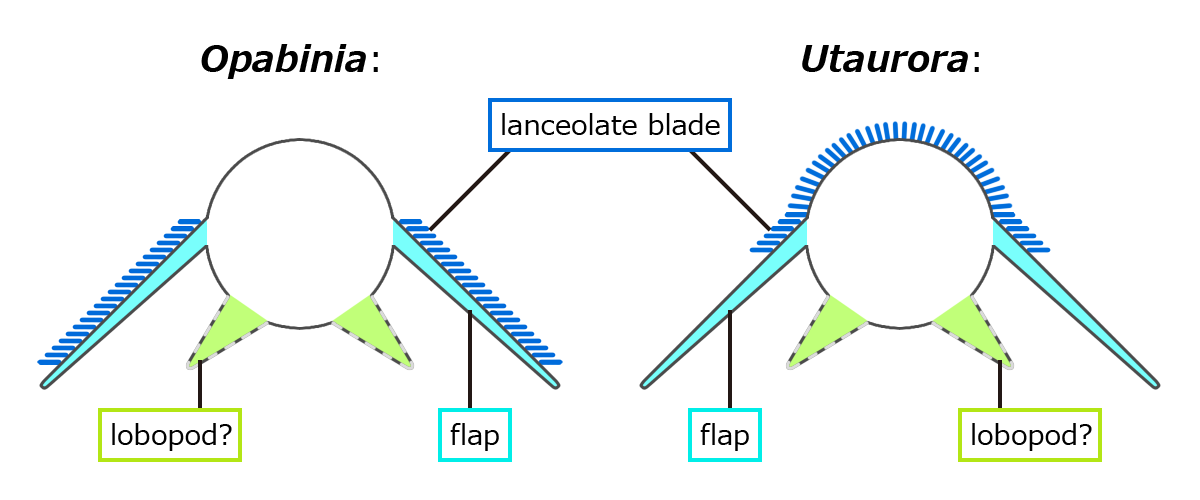|
Arthropoda
Arthropods (, (gen. ποδός)) are invertebrate animals with an exoskeleton, a Segmentation (biology), segmented body, and paired jointed appendages. Arthropods form the phylum Arthropoda. They are distinguished by their jointed limbs and Arthropod cuticle, cuticle made of chitin, often Mineralization (biology), mineralised with calcium carbonate. The arthropod body plan consists of segments, each with a pair of appendages. Arthropods are bilaterally symmetrical and their body possesses an exoskeleton, external skeleton. In order to keep growing, they must go through stages of moulting, a process by which they shed their exoskeleton to reveal a new one. Some species have wings. They are an extremely diverse group, with up to 10 million species. The haemocoel, an arthropod's internal cavity, through which its haemolymph – analogue of blood – circulates, accommodates its interior Organ (anatomy), organs; it has an open circulatory system. Like their exteriors, the internal or ... [...More Info...] [...Related Items...] OR: [Wikipedia] [Google] [Baidu] |
Radiodonta
Radiodonta is an extinct Order (biology), order of stem-group arthropods that was successful worldwide during the Cambrian period. They may be referred to as radiodonts, radiodontans, radiodontids, anomalocarids, or anomalocaridids, although the last two originally refer to the family Anomalocarididae, which previously included all species of this order but is now restricted to only a few species. Radiodonts are distinguished by their distinctive frontal appendages, which are morphologically diverse and used for a variety of functions. Radiodonts included the earliest large predators known, but they also included sediment sifters and filter feeders. Some of the most famous species of radiodonts are the Cambrian taxa ''Anomalocaris, Anomalocaris canadensis'', ''Hurdia, Hurdia victoria'', ''Peytoia nathorsti'', ''Titanokorys gainesii, Titanokorys gainessii, Cambroraster, Cambroraster falcatus'' and ''Amplectobelua, Amplectobelua symbrachiata'', the Ordovician ''Aegirocassis, Aegiroca ... [...More Info...] [...Related Items...] OR: [Wikipedia] [Google] [Baidu] |
Lobopodia
The lobopodians, members of the informal group Lobopodia (from the Greek language, Greek, meaning "blunt feet"), or the formally erected phylum Lobopoda Cavalier-Smith (1998), are panarthropods with stubby legs called lobopods, a term which may also be used as a common name of this group as well. While the definition of lobopodians may differ between literatures, it usually refers to a group of soft-bodied, worm-like fossil panarthropods such as ''Aysheaia'' and ''Hallucigenia''. The oldest near-complete fossil lobopodians date to the Lower Cambrian; some are also known from Ordovician, Silurian and Carboniferous Lagerstätten. Some bear toughened claws, plates or spines, which are commonly preserved as small carbonaceous fossil, carbonaceous or Small Shelly Fossils, mineralized microfossils in Cambrian strata. The grouping is considered to be paraphyletic, as the three living panarthropod groups (Arthropoda, Tardigrada and Onychophora) are thought to have evolved from lobopodian ... [...More Info...] [...Related Items...] OR: [Wikipedia] [Google] [Baidu] |
Dinocaridida
DinocarididaGreek, "Terrible crabs" – sometimes informally spelt Dinocarida, but the second 'id' is linguistically correct – see is a proposed fossil taxon of basal arthropods that flourished in the Cambrian period with occasional OrdovicianVan Roy, P.; Briggs, D. E. G. (2011). "A giant Ordovician anomalocaridid". Nature 473 (7348): 510–513. doi:10.1038/nature09920. edit and Devonian records. Characterized by a pair of frontal appendages and series of body flaps, the name of Dinocaridids comes from Greek language, Greek, "deinos" and "caris" ("terrible crab"), referring to the suggested role of some of these members as the largest Marine life, marine Predation, predators of their time. Dinocaridids are occasionally referred to as the 'AOPK group' by some literatures, as the group compose of Radiodonta (''Anomalocaris'' and relatives), Opabiniidae (''Opabinia'' and relatives), ''Pambdelurion'' and ''Kerygmachela.'' It is most likely paraphyletic, with ''Kerygmachela'' and ' ... [...More Info...] [...Related Items...] OR: [Wikipedia] [Google] [Baidu] |
Fuxianhuiida
Fuxianhuiida is an extinct clade of arthropods from the Cambrian of China. All currently known species are from Cambrian Series 2 aged deposits in Yunnan Province, including the Chengjiang biota. They are generally considered to be close to the base of Euarthropoda, but have also been considered to be early mandibulates. Many specimens are known with exceptional soft tissue preservation, including preserved guts and neural tissue, which given their basal phylogenetic position makes them important in understanding the evolution of arthropoda as a whole. They reach a size of up to 15 cm, and are interpreted as benthic predators and scavengers. The fuxianhuiid exoskeleton is unmineralised, and the number of tergites ranges from 15 to over 40. The cephalon is covered by a head shield and contains stalked eyes connected by the anterior sclerite, antennae, a butterfly shaped hyposome and a posterior facing mouth. Fuxianhuiids possess specialized post-antennal appendages with se ... [...More Info...] [...Related Items...] OR: [Wikipedia] [Google] [Baidu] |
Pambdelurion
''Pambdelurion'' is an extinct genus of panarthropod from the Cambrian aged Sirius Passet site in northern Greenland. Like the morphologically similar ''Kerygmachela'' from the same locality, ''Pambdelurion'' is thought to be closely related to arthropods, combining characteristics of " lobopodians" with those of primitive arthropods. Description ''Pambdelurion'' was large for a Cambrian animal, and is estimated to have reached a length of . ''Omnidens'', an organism from China that closely resembles ''Pambdelurion'' and may even be synonymous with it, reached even larger sizes, estimated to be based on the proportions of ''Pambdelurion''. The head of ''Pambdelurion'' bore a large pair of frontal appendages, homologous to the antennae of onychophorans and frontal appendages of radiodonts. These frontal appendages were weakly muscled and relatively soft, suggesting they may have served primarily as sensory organs, rather than for grasping prey. Between the appendages are a pair ... [...More Info...] [...Related Items...] OR: [Wikipedia] [Google] [Baidu] |
Trilobite
Trilobites (; meaning "three lobes") are extinct marine arthropods that form the class Trilobita. Trilobites form one of the earliest-known groups of arthropods. The first appearance of trilobites in the fossil record defines the base of the Atdabanian stage of the Early Cambrian period () and they flourished throughout the lower Paleozoic before slipping into a long decline, when, during the Devonian, all trilobite orders except the Proetida died out. The last extant trilobites finally disappeared in the mass extinction at the end of the Permian about 252 million years ago. Trilobites were among the most successful of all early animals, existing in oceans for almost 270 million years, with over 22,000 species having been described. By the time trilobites first appeared in the fossil record, they were already highly diversified and geographically dispersed. Because trilobites had wide diversity and an easily fossilized exoskeleton, they left an extensive fossil record. The stu ... [...More Info...] [...Related Items...] OR: [Wikipedia] [Google] [Baidu] |
Trilobita
Trilobites (; meaning "three lobes") are extinction, extinct marine arthropods that form the class (biology), class Trilobita. Trilobites form one of the earliest-known groups of arthropods. The first appearance of trilobites in the fossil record defines the base of the Atdabanian Stage (geology), stage of the Early Cambrian Period (geology), period () and they flourished throughout the lower Paleozoic before slipping into a long decline, when, during the Devonian, all trilobite orders except the Proetida died out. The last extant trilobites finally disappeared in Permian–Triassic extinction event, the mass extinction at the end of the Permian about 252 million years ago. Trilobites were among the most successful of all early animals, existing in oceans for almost 270 million years, with over 22,000 species having been described. By the time trilobites first appeared in the fossil record, they were already highly diversified and geographically dispersed. Because trilobites had ... [...More Info...] [...Related Items...] OR: [Wikipedia] [Google] [Baidu] |
Nektaspida
Nektaspida (also called Naraoiida, Nektaspia and Nectaspida) is an extinct order of non- mineralised artiopodan arthropods. They are known from the mid-Cambrian to the upper Silurian. Originally classified as trilobites, which they superficially resemble, they are now placed as close relatives as members of the Trilobitomorpha within Artiopoda. The order is divided into three major families; Emucarididae, Liwiidae, and Naraoiidae. Naming history and taxonomic placement The order was originally proposed by Raymond in 1920 as Nektaspia. Størmer corrected it to Nectaspida for the 1959 ''Treatise on Invertebrate Paleontology'' to conform with the names of the other trilobite orders. Whittington described it in 1985 with the spelling Nektaspida; the revised 1997 Treatise by Raymond and Fortey uses this spelling, as do other modern works. Whittington (1985) placed the order in the Trilobita. Cotton & Braddy (2000) place it in a new "Trilobite clade" containing the Trilobita, recogni ... [...More Info...] [...Related Items...] OR: [Wikipedia] [Google] [Baidu] |
Anomalocaris
''Anomalocaris'' ("unlike other shrimp", or "abnormal shrimp") is an extinct genus of Radiodonta, radiodont, an Order (biology), order of early-diverging stem-group arthropods. The first fossils of ''Anomalocaris'' were discovered in the ''Ogygopsis'' Shale of the Stephen Formation in British Columbia, Canada by Joseph Frederick Whiteaves, with more examples found by Charles Doolittle Walcott in the Burgess Shale unit of the Stephen Formation. Other closely related fossils have been found in the older Emu Bay Shale of Australia, as well as possibly elsewhere. Originally several fossilized parts discovered separately (the mouth, frontal appendages and trunk) were thought to be three separate creatures, a misapprehension corrected by Harry B. Whittington and Derek Briggs in a 1985 journal article. With a body length close to 40 centimetres, ''A. canadensis'' is thought to be one of the earliest examples of an apex predator, though others have been found in older Cambrian lagerstätte ... [...More Info...] [...Related Items...] OR: [Wikipedia] [Google] [Baidu] |
Bradoriida
Bradoriids are an extinct order of small marine arthropods with a bivalved carapace, and were globally distributed, forming a significant portion of the Cambrian and Early Ordovician soft-bodied communities. Affinity Whilst the Bradoriida were traditionally considered as relatives of the modern bivalved arthropod group Ostracoda, the anatomy of their appendages does not support such a relationship; neither are they related to the Cambrian bivalved arthropod group Phosphatocopida. Rather, they are most probably related to the Eucrustacea at a stem-group level. An in-depth phylogenetic analysis of Panarthropoda included two bradoriid genera, '' Kunyangella'' and ''Kunmingella'', and recovered them as the most basal stem- mandibulates. Occurrence Bradoriida are geographically widespread, and first occur in the fossil record shortly before the earliest trilobite Trilobites (; meaning "three lobes") are extinct marine arthropods that form the class Trilobita. Trilobites fo ... [...More Info...] [...Related Items...] OR: [Wikipedia] [Google] [Baidu] |
Kerygmachela
''Kerygmachela kierkegaardi'' is a gilled lobopodian from the Cambrian Stage 3 aged Sirius Passet Lagerstätte in northern Greenland. Its anatomy strongly suggests that it, along with its relative ''Pambdelurion whittingtoni'', was a close relative of radiodont (anomalocaridids) and euarthropods. The generic name "Kerygmachela" derives from the Greek words ''Kerygma'' (proclamation) and ''Chela'' (claw), in reference to the flamboyant frontal appendages. The specific name, "kierkegaardi" honors Danish philosopher Søren Kierkegaard. Morphology The head of ''Kerygmachela'' possesses a pair of well-developed frontal appendages which correspond to those of other dinocaridids and siberiid lobopodians. Each of them terminates in a series of long spines. A pair of sessile, slit-like compound eyes is located slightly behind the base of these appendages. A small anterior-facing mouth is located below the head and bears a pair of stylet-like structures. The head also possesses a ... [...More Info...] [...Related Items...] OR: [Wikipedia] [Google] [Baidu] |
Opabiniidae
Opabiniidae is an extinct family of bizarre marine stem-arthropods. Its type and best-known genus is ''Opabinia''. It also contains ''Utaurora''. Opabiniids closely resemble radiodonts, but their frontal appendages were basally fused into a proboscis. Opabiniids also distinguishable from radiodonts by setal blades covering at least part of the body flaps and serrated caudal rami. History of study Opabiniidae was named by Charles Doolittle Walcott in 1912, alongside its type species ''Opabinia''. Walcott interpreted Opabiniidae as a family of anostracan crustaceans, most closely related to Thamnocephalidae. ''Opabinia'' was restudied in the 1970s, and reinterpreted as a stranger animal. Stephen Jay Gould referred to ''Opabinia'' as a "weird wonder", and an illustration of ''Opabinia'' prompted laughter when it was first revealed at a paleontological conference. In 2022, a second opabiniid, ''Utaurora'', was identified. ''Myoscolex'' from Emu Bay Shale is sometimes suggested to ... [...More Info...] [...Related Items...] OR: [Wikipedia] [Google] [Baidu] |





.jpg)



